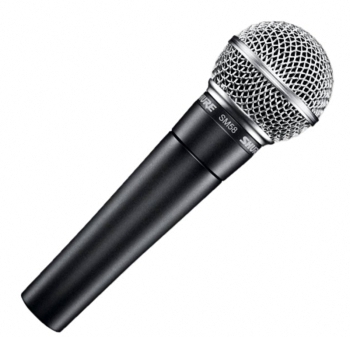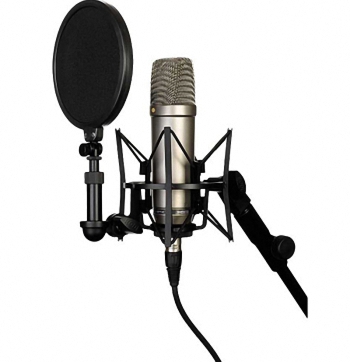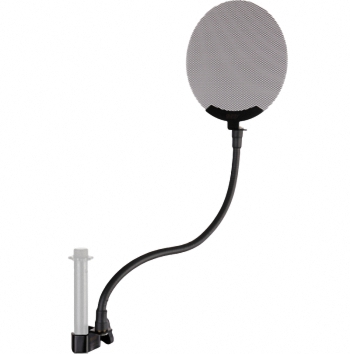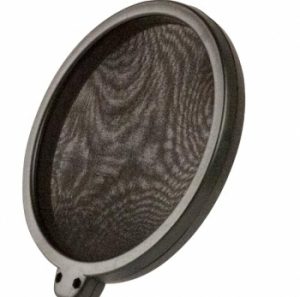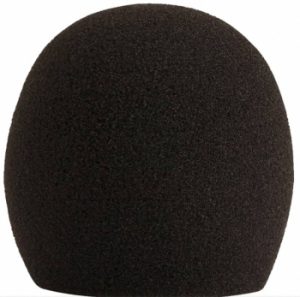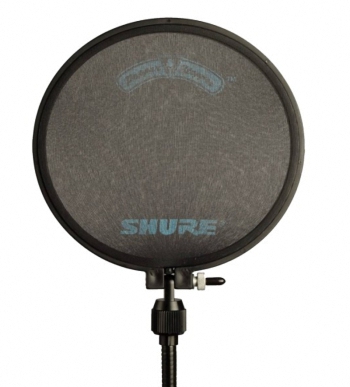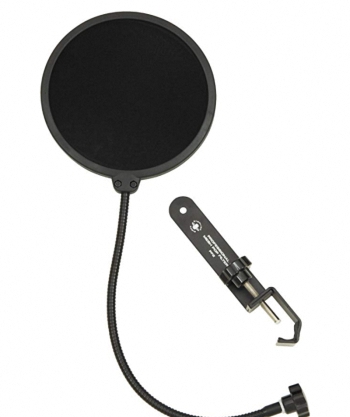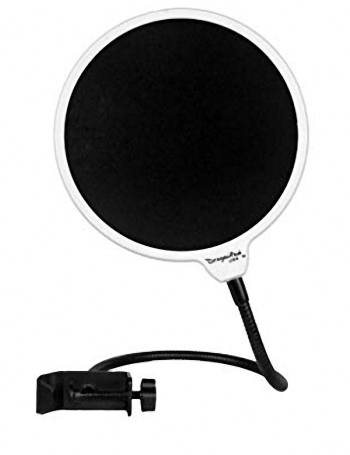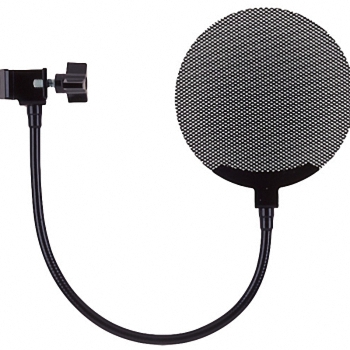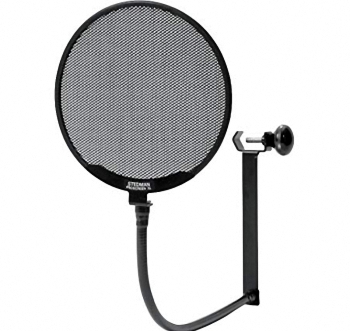
Vocals are an incredibly important component of most music. Incidentally, they’re also one of the hardest elements to get right, not just in terms of performance but in recording, mixing and mastering.
A key but frequently overlooked component of recording quality vocals anywhere – in pro or home studios – is the humble pop filter!
However, armed with the right tips, tricks, and skills, it’s easily possible to record high-quality vocals even from within a home studio or budget setup.
Vocal recording isn’t just about recording lyrics, either. The voice is an instrument and you can use it to create all sorts of vocal lines, phrases, samples, sound effects, and even synth or basslines a la DUB FX.
Of course, like any instrument, the process begins with audio capture. You have a microphone, perhaps an interface, and your DAW, so what is missing?
One key ingredient: a pop shield/filter!
The Pop Filter
Pop filters are a way too often overlooked component of vocal recording. They’re so simple but so incredibly important. People think that microphones are designed with pop filters built into the mic head which is often filled with foam or similar material.
This isn’t actually correct, though, as whilst the microphone head can absorb some shock and overt breaths of air, plosives, etc, it can’t fully prevent larger pops from ruining your recording (and that’s what they’ll do).
It’s true that the head of say a Shure SM57 (below) does feature somewhat of a pop-shield to prevent air from flowing straight into the microphone but still, it’s not enough on its own. Instead, a pop filter which attaches straight to your mic stand is the best bet by far!
What Does a Pop Filter Prevent?
If you’ve listened back to a vocal recording recorded without a pop filter then you will have likely heard audible pops, crackles and other strange glitch-like sounds.
But Why?
When we speak or sing, some sounds expel greater air from our mouth’s than others.
Words with Ps or Bs in them typically create the loudest pops – if you place your hand close to your mouth and say ‘pop’ you’ll notice how much air hits your hand. These sounds are called plosives.
Other sounds, like the sound of the letter S, produce what’s called sibilance which can sound hissy on recordings.
Pops can clip your recordings and when you add FX and processing, they may become even more obvious, nasty and hard to deal with!
A pop filter eliminates the effects of these unwanted sounds, smoothing out your vocal and giving it a richer and more accurate tone.
It’s actually amazing how much of a difference a pop filter can make – you won’t know until you try it!
The Candle Experiment
To demonstrate the quantity of air expelled when we say P or B, you can light a candle or lighter flame and say the letters projected towards the flame. The flame will often go out from the force of air when you say P or B, or at least flicker. Air moving from the mouth travels extremely quickly – a sneeze travels at speeds over 150 km/h! Obviously, the average plosive isn’t this dramatic but some singers are extremely loud – plosives can become very loud very quickly if they’re not controlled!
To compare the letters P or B to other vocal sounds, try saying words without Ps or Bs, like “am” or “are”. You’ll notice that the flame barely moves at all!
It’s interesting to go through the alphabet to observe what sounds produce virtually no air movement and those that do.
Plosives are only one half of the issue, though!
The Proximity Effect
The proximity effect occurs with most microphones, regardless of the in-built padding they have in their mic head.
The proximity effect increases low-frequency content when you place a sound source too close to a mic. When mixing up a bass, you might have noticed that a distant mic barely picks up bass but as soon as you move it just a tad closer, you get a serious boom! Sound frequencies resonate with the mic capsule when they’re placed too close to a microphone, this is problematic when recording vocals.
Microphones with larger diaphragms are more likely to experience the proximity effect. A sensitive condenser with a large diaphragm is probably the worst candidate.
In fact, for some condensers or ribbon mics used at high-gains, plosives can actually cause serious damage. They can also clip limiters, compressors, EQs and other gear in the signal chain causing untold horror and difficulties for recording!
The Issue of Saliva!
Saliva projecting from the mouth when we say plosive words can actually corrode your microphone and cause permanent damage. Imagine realizing spit has destroyed your best microphone? It’s a real possibility if you don’t use a pop shield.
In particular, rappers who put the microphone right to their mouth probably eject a large amount of saliva into the microphone throughout a performance (hence why rapping in the UK is called spitting!) The louder the vocals, the more likely this is.
Pop filters can absorb saliva projecting from the mouth to prevent catastrophic and long term damage.
So What Actually is A Pop Filter?
A pop filter is a device placed between the mouth and microphone. It disrupts and absorbs air flow, vastly smoothing the dynamics of vocals entering the microphone.
It’s a simple piece of kit but there’s many available on the market and they’re not all super-cheap, some are pretty advanced and produce great results.
The Benefits of Pop Filters
Pop shields confer several benefits to vocal recordings. They’re simple but powerful tools to enhance your vocal tone whilst reducing the harmful effects of plosives and spit.
- They help prevent or reduce the effect of plosive sounds
- They can smooth vocal dynamics and tighten vocal tone
- Thicker pop filters can almost mute vocals, this makes them more easily effective (e.g. if you’re recording a vocal bassline and want to add chorus or reverb)
- Pop filters prevent spit from entering the mic capsule
What Are Pop Filters Made From?
Pop filters are generally made from woven nylon sheets layered up and stretched over a circular form but they can be made from metal also. They’re generally tuned to absorb low and ultra-low frequencies whilst reducing the dynamics of plosive peaks.
Pop filters allow most high frequencies and mid frequencies to pass through freely as these don’t cause plosive or proximity effect issues. The idea is to keep the vocal in-act whilst removing unwanted frequency content. However, some pop-filters smooth the dynamics of the entire vocal range to create a more muted tone. This is perfect for smaller studios, vocal booths, or when you’re recording with budget microphones and interfaces.
Whilst you’re probably familiar with the basic form of a pop-filter, you might not be aware that there are several different varieties available.
Metal Pop Filters
Metallic pop filters are very simple – they’re usually created from steel or aluminum mesh. They’re perfect for when you have a well-trained vocalist or one with a particularly soft voice.
Pros
- Metallic pop filters don’t suppress many or any higher frequencies
- Durable
- Easy to maintain
Cons
- Won’t smooth or mute a less perfect vocal line
- Prone to bending
Nylon Pop Filters
Nylon is very much the classic pop-filter material. It helps suppress more of the vocal range to create smoother vocal lines. It won’t completely mute the tone of a voice but it will certainly help smooth it over.
Pros:
- Can smooth a vocal line
- Easy to get hold of and cheap
- It’s what most vocalists are used to
Cons
- Can get dirty and rip
Foam Pop Filters
Foam windshields will absorb large amounts of bass frequencies. They’re often placed over microphones when recording outside to block out noise from wind. They’re less useful for vocal performances.
Pros
- Smooths many frequencies
- Largely eliminates bass
- Cheap and easy to replace
Cons
- Can block out too many higher frequencies
Which Do I Choose?
It depends!
- For outside recording, recording in areas with background ambiance or recording in windy situations, a foam cover can help reduce unwanted lows and resonant frequencies.
- For recording professional or very smooth and well-trained vocalists, metal pop filters can preserve higher frequencies and will not alter the vocal tone as drastically.
- Generally, nylon pop filters are the go-to or industry standard. They’ll clamp down on plosives whilst leaving the vocal mostly intact.
If you can, try all 3 and use the one which best produces the tone you want. Sometimes, we’ll want to record a flatter more muted tone for which a foam shield will suit well, even in a studio. Softer or quieter vocalists may sound too muted through even a nylon pop filter, though. Nylon is the all-rounder but it’s entirely possible a different filter will sound better on your recording setup and mic.
So what are the best pop filters? Fortunately, there’s tons of choice. Ranging from cheap options to high-end pro studio models, pop filters are readily available at all price points. There are no excuses for not adding one to your setup!
1. Shure Popper Stopper Pop Filter with Metal Gooseneck and Heavy Duty Microphone Stand Clamp
Shure is an industry veteran so it’s no wonder this premium pop filter is one of the best selling of all time.
It features a 4-layer screen to vastly reduce the harmful effects of plosives. With an awesome adjustable gooseneck stand and heavy-duty clamp, it’s sure to serve any studio well for years to come! With 4 layers, it may seem like this pop filter will mute vocals but actually, it effectively preserves vocal clarity.
- 6-inch screen diameter
- 14-inch adjustable gooseneck
- Strong clamp for mic stands
2. Sterling Audio STPF2 Professional Mesh Pop Filter
This filter from top manufacturer Sterling Audio is strong and cost-effective. It’s a low-cost option that easily fulfills basic pop-filter duties with a 2 layer shield and adjustable gooseneck stand. It’s a simple but durable device at a superb price.
- Double layer
- 13-inch gooseneck
- Strong mounting bracket
3. Dragonpad USA 6″ Microphone Studio Pop Filter with Clamp
Even though it’s extremely cheap, this is one of the best well-reviewed pop filters on Amazon. It’s double layered and comes with a lengthy and strong gooseneck clamp. It’s also available in a selection of funky colors! Simple but effective.
- 13-inch gooseneck
- Double layered nylon
- Quality bracket
4. Royer PS-101 Metal Pop Filter
The Royer metal pop filter is a tad pricey but it’s a brilliant choice for vocalists who want to let wispy high frequencies safely. With a strong mesh weave filter, a brilliant stand, and an extremely strong clip, you can’t deny how well-made this pop filter is.
- Single screen high-quality woven mesh
- 4.6-inch diameter
- 13-inch gooseneck
5. Stedman Proscreen XL Pop Filter
Finally, this real high-end pop filter caters to the very best vocalists. It’s created some a special highly advanced material and is more effective at specifically targeting problematic plosives than other pop filters. It keeps vocals extremely organic, natural and smooth whilst reducing problematic plosives.
- Special mesh screen
- 6-inch diameter
- 26.5-inch gooseneck
Conclusion
Pop filters are incredibly important but very simple. They’re inexpensive to add to your setup and can greatly improve the vocal sound in smaller or budget studios. When recording some vocalists, you’ll realize that there really is no alternative to using a pop shield if you want to avoid all manner of weird sounds and spit from entering the microphone – harsh but true!
And then there’s the small (massive) issue of spit entering your mic and destroying it!
Also, pop filters can really enhance vocals by smoothing their dynamics. They aren’t just a utility tool, but a creative one too.
The pop shields here are all incredible options and they’ll enhance your vocal recordings considerably. They’ll make straightforward but powerful additions to your setup. Make sure you choose the right type of pop filter for your vocal recordings but if in doubt, go for the classic nylon pop filter!
Happy pop shielding!
